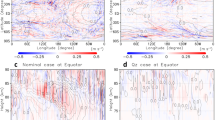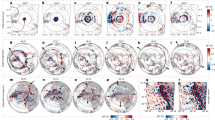Abstract
The Akatsuki spacecraft observed a 10,000-km-long meridional structure at the top of the cloud deck of Venus that appeared stationary with respect to the surface and was interpreted as a gravity wave. Additionally, over four Venus solar days of observations, other such waves were observed to appear in the afternoon over equatorial highland regions. This indicates a direct influence of the solid planet on the whole Venusian atmosphere despite dissimilar rotation rates of 243 and 4 days, respectively. How such gravity waves might be generated on Venus is not understood. Here, we use general circulation model simulations of the Venusian atmosphere to show that the observations are consistent with stationary gravity waves over topographic highs—or mountain waves—that are generated in the afternoon in equatorial regions by the diurnal cycle of near-surface atmospheric stability. We find that these mountain waves substantially contribute to the total atmospheric torque that acts on the planet’s surface. We estimate that mountain waves, along with the thermal tide and baroclinic waves, can produce a change in the rotation rate of the solid body of about 2 minutes per solar day. This interplay between the solid planet and atmosphere may explain some of the difference in rotation rates (equivalent to a change in the length of day of about 7 minutes) measured by spacecraft over the past 40 years.
This is a preview of subscription content, access via your institution
Access options
Access Nature and 54 other Nature Portfolio journals
Get Nature+, our best-value online-access subscription
$29.99 / 30 days
cancel any time
Subscribe to this journal
Receive 12 print issues and online access
$259.00 per year
only $21.58 per issue
Buy this article
- Purchase on Springer Link
- Instant access to full article PDF
Prices may be subject to local taxes which are calculated during checkout



Similar content being viewed by others
Change history
15 October 2018
In the version of this Article originally published, a statement regarding past measurements of the length of day and rotation rate of Venus was potentially misleading. The original statement has now been replaced in the online versions of this Article, to acknowledge that neither Magellan nor Venus Express measured an instantaneous rotation rate.
References
Fukuhara, T. et al. Large stationary gravity wave in the atmosphere of Venus. Nat. Geosci. 10, 85–88 (2017).
Schubert G. in Venus (eds Hunten, D. M. et al.) 681–765 (Univ. Arizona Press, Tuscon, 1983).
Kouyama, T. et al. Topographical and local time dependence of large stationary gravity waves observed at the cloud top of Venus. Geophys. Res. Lett. 44, 12098–12105 (2017).
Lebonnois, S. et al. Superrotation of Venus’ atmosphere analyzed with a full general circulation model. J. Geophys. R. 115, E06006 (2010).
Lebonnois, S., Sugimoto, N. & Gilli, G. Wave analysis in the atmosphere of Venus below 100-km altitude, simulated by the LMD Venus GCM. Icarus 278, 38–51 (2016).
McFarlane, N. A. The effect of orographically excited gravity wave drag on the general circulation of the lower stratosphere and troposphere. J. Atmos. Sci. 44, 1775–1800 (1987).
Lott, F. & Miller, M. J. A new subgrid-scale orographic drag parametrization: its formulation and testing. Q. J. R. Meteorol. Soc. 123, 101–127 (1997).
Scinocca, J. F. & McFarlane, N. A. The parametrization of drag induced by stratified flow over anisotropic orography. Q. J. R. Meteorol. Soc. 126, 2353–2393 (2000).
Collins, M., Lewis, S. R. & Read, P. L. Gravity wave drag in a global circulation model of the martian atmosphere: Parameterisation and validation. Adv. Space Res. 19, 1245–1254 (1997).
Forget, F. et al. Improved general circulation models of the Martian atmosphere from the surface to above 80 km. J. Geophys. Res. 104, 24155–24175 (1999).
Haus, R., Kappel, D. & Arnold, G. Atmospheric thermal structure and cloud features in the southern hemisphere of Venus as retrieved from VIRTIS/VEX radiation measurements. Icarus 232, 232–248 (2014).
Miranda, P. M. A. & James, I. N. Non-linear three-dimensional effects on gravity-wave drag: splitting flow and breaking waves. Q. J. R. Meteorol. Soc. 118, 1057–1081 (1992).
Lebonnois, S. et al. Angular momentum budget in General Circulation Models of superrotating atmospheres: a critical diagnostic. J. Geophys. Res. 117, 12004 (2012).
Mueller, N. T., Helbert, J., Erard, S., Piccioni, G. & Drossart, P. Rotation period of Venus estimated from Venus Express VIRTIS images and Magellan altimetry. Icarus 217, 474–483 (2012).
Cottereau, L., Rambaux, N., Lebonnois, S. & Souchay, J. The various contributions in Venus rotation rate and LOD. Astron. Astrophys. 531, A45 (2011).
Gold, T. & Soter, S. Atmospheric tides and the resonant rotation of Venus. Icarus 11, 356–366 (1969).
Takagi, M. & Matsuda, Y. Effects of thermal tides on the Venus atmospheric superrotation. J. Geophys. Res. 112, D09112 (2007).
Leconte, J., Wu, H., Menou, K. & Murray, N. Asynchronous rotation of Earth-mass planets in the habitable zone of lower-mass stars. Science 347, 632–635 (2015).
Auclair-Desrotour, P., Laskar, J., Mathis, S. & Correia, A. C. M. The rotation of planets hosting atmospheric tides: from Venus to habitable super-Earths. Astron. Astrophys. 603, A108 (2017).
Correia, A. C. M. & Laskar, J. The four final rotation states of Venus. Nature 411, 767 (2001).
Garate-Lopez, I. & Lebonnois, S. Impacts of the cloud structure’s latitudinal variation on the general circulation of the Venus atmosphere as modeled by the LMD-GCM. EGU Geophys. Res. Abstracts 19, 12972 (2017).
Ford, P. G. & Pettengill, G. H. Venus topography and kilometer-scale slopes. J. Geophys. Res. 97, 13103–13114 (1992).
Smith, R. B. Linear theory of stratified hydrostatic flow past an isolated mountain. Tellus 32, 348–364 (1980).
Phillips, D. S. Analytical surface pressure and drag for linear hydrostatic flow over three-dimensional elliptical mountains. J. Atmos. Sci. 41, 1073–1084 (1984).
Acknowledgements
We thank NASA for its financial support (grant NNX16AC84G) and the Akatsuki team for its discussions.
Author information
Authors and Affiliations
Contributions
T.N. performed the simulations, model development and scientific interpretation; G.S. contributed to the scientific interpretation, and S.L. to the model development and simulations.
Corresponding author
Ethics declarations
Competing interests
The authors declare no competing interests.
Additional information
Publisher’s note: Springer Nature remains neutral with regard to jurisdictional claims in published maps and institutional affiliations.
Supplementary information
Rights and permissions
About this article
Cite this article
Navarro, T., Schubert, G. & Lebonnois, S. Atmospheric mountain wave generation on Venus and its influence on the solid planet’s rotation rate. Nature Geosci 11, 487–491 (2018). https://doi.org/10.1038/s41561-018-0157-x
Received:
Accepted:
Published:
Issue Date:
DOI: https://doi.org/10.1038/s41561-018-0157-x
This article is cited by
-
Venus, the Planet: Introduction to the Evolution of Earth’s Sister Planet
Space Science Reviews (2023)
-
Atmospheric dynamics of a near tidally locked Earth-sized planet
Nature Astronomy (2022)
-
Spin state and moment of inertia of Venus
Nature Astronomy (2021)
-
BepiColombo Science Investigations During Cruise and Flybys at the Earth, Venus and Mercury
Space Science Reviews (2021)
-
Influence of the cloud-level neutral layer on the vertical propagation of topographically generated gravity waves on Venus
Earth, Planets and Space (2019)



